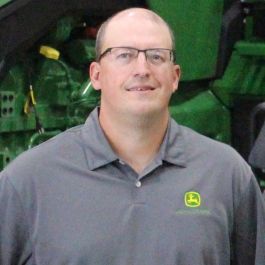John Deere’s Innovation Doesn’t Just Impact Farmers. It Helps to Save the Planet.
The fundamentals of agriculture haven’t changed much in 12,000 years: planting seeds, watering, feeding, and harvesting. Has there really been much interaction to a relatively straightforward process?
Actually, yes.
John Deere, the legacy agricultural machinery company, has been out to modernize farming for nearly two decades, using a holistic approach to help farmers become more effective in their production systems. But underneath the iconic green exterior of its machinery hums a network of sophisticated software, IoT technology, cloud capability and cutting-edge sensors harvesting a staggering amount of data.
To John Deere’s team, the future of farming lies not only in the earth itself, but in the mind-boggling amount of data they’ve collected over the years, containing information about a machine’s performance all the way down to a single patch of weeds in a soybean crop. With such detailed data, technologists can diagnose issues before they even occur, giving farmers the highest possible uptime on their machines and unprecedented insight into the health of their crops.
“We deal with tens of thousands of values per second coming into our data platform,” Senior Principal Software Engineer Greg Finch said. “We use multiple petabyte data tables to store all of that information; our biggest table has about 25 trillion records in it. More than half of that has been collected in the last three years.”
While working with big data has become every data scientists’ dream over the last few years, Group Engineering Manager of Data Products Sooraj Ali said that the John Deere team isn’t strictly motivated by all of the cutting-edge tech they get to work with. Their work in unlocking agricultural efficiency comes with a significant, real-world impact.
“By helping our customers and dealers improve production cycles, we believe that we can contribute toward solving crises,” Ali said. “The world’s population is expected to grow to around 9.8 billion by 2050. That means farmers need to produce twice the amount of food they currently are.”
Those increases in food production can’t happen without modern technology. By equipping farmers — the original environmentalists — with valuable information, John Deere’s technology provides unprecedented insights that directly translate into more efficient growing cycles, higher uptimes on machinery and more sustainable agricultural practices. Helping farmers reduce chemical inputs, for example, means using less fuel, which in turn means lower CO2 emissions, while reducing the number of trips over the same patch of ground in a field improves soil health and reduces erosion. All of these measures (and more) allow John Deere employees to feel good about their role as stewards of the land.
In a conversation with four of the company’s tech leaders, Built In uncovered the story of how John Deere transformed the farming industry. The culmination of this team’s work has created an impact that can be felt not only by John Deere’s customers, whose livelihood depends on high performing crops, but also on anyone who shops at a grocery store or sits down at a restaurant.

How does John Deere enable higher uptime in its machinery? Why is this important?
Group Engineering Manager, Data Products Sooraj Ali: In 2014, I was working in John Deere’s largest factory in Waterloo, Iowa. I was working on my thesis at the time, which was centered on finding problems before they find us. One challenge we faced was downtime for some of our largest machines. Combines aren’t cheap — they can run more than half a million dollars, and they only operate for about 18 days every year. Otherwise, if you harvest a crop outside of a certain moisture content, farmers don’t get a good price for their commodity and lose money. That piece of machinery better be functioning every second of that short window.
Wanting to improve the time, we thought about how we have a lot of telematics alerts being rolled out from our machines in the fields. We realized, with all of that data, we could detect emerging issues. We thought it would be cool to get these alerts from the machines, like cars do when you’re running low on fuel, for example.
Those insights are now used to inform dealers that, say, within the next two weeks, there’s a certain probability that an issue will happen with a customer’s machinery. Then, dealers can send corrective actions before the customer even is aware of the issue. Bottom line is, when we have faster issue detection, it reduces the problem-resolution cycle time. We’ll make sure that, when you have 18 days to run a combine, it will run at its best operating level.
Engineering Manager Jayashree Karnam: The element of seasonality is very important to farmers. They only get so many good days where they can either plant or harvest. On those days, they just want to maximize their equipment and need it to function at its best.
One of the ways we use technology is through data and connectivity. Through all of these connected machines, we collect tons of data, which data scientists from different engineering departments constantly look at to identify patterns or if any failure modes are expected. We use this intelligence to deliver insights called Expert Alerts. These alerts empower our dealers to have meaningful conversations with customers about possible issues with their machinery, and then fix them before something goes wrong. By doing this, we ensure our customers have the highest uptime possible on their equipment when they need it most.
Project Lead Engineer, Vehicles Jeremy L’Heureux: In the past, we were really good at reacting to problems. What this project allowed us to do was really hook together many different data streams and put them in a format that many people were capable of working with, instead of just one or two employees. That way, we can see larger patterns and enhance our tools so many people can find issues and enable our company to respond faster, allow dealers to be more prepared and ultimately, enable customers to have increased uptime.
Talk to us about the amount of data you’re collecting, and how your team has evolved to collect even more.
Senior Principal Engineer Greg Finch: A long time ago, when we first started putting sensors on our machines, we’d get datasets back, but they were fairly low resolution. Every 30 minutes, the machine would aggregate everything that had happened in the last half hour, and send that to our servers. We realized that view was beneficial for some things, but what we really wanted to aspire to was plant-level management. That means we wanted to know what was happening with every plant in a given field. To do that, you have to measure with very high-resolution data.
We started collecting what we call agronomic data, which is data about what we’re doing to the ground and the plants. For example, if we’re dealing with a planter that has 16 row units, each of those row units will have maybe eight sensor readings that happen on it. We capture those readings at least one time a second, sometimes five times a second. We can do the same thing with what’s happening in the machine itself. Take that amount of data we’re collecting from one machine, and multiply it across our entire fleet.
Working on the scale of these projects is big, it’s challenging, but it’s fun.”
Every year, we’ve been on a pretty steep curve up as far as growth and data drivers because there are now more sensors on machines, higher resolution collected and more machines outfitted with devices and connected to the cloud. Working on the scale of these projects is big, it’s challenging, but it’s fun.
L’Heureux: When we started about 10 years ago to make telematics for our large products, I remember we were working with really simple tools. But thanks to the organization’s quick understanding that we needed something different and more complex, this journey has really accelerated. Every day, our data collection increases in rate. It’s amazing to think about the amount of data we’re now gathering and where we started from. It’s a pretty fascinating accomplishment for the amount of time that’s gone by.
Working together to build Expert Alerts

How is John Deere able to build hardware and software that work well together?
Karnam: We’re continuously looking to advance our technology, and collaboration between teams is really the key. Even today, our teams work very closely with a lot of engineering groups, which each come with their own domain and engineering expertise. What we are bringing to the table now is the IT and software engineering knowledge, the right processes and tools to maximize output.
As we now look forward, we’re talking about applying machine learning, and the models we want to build. The challenges are always there, but come in different formats. We’ve learned to work together and bring each other’s strengths to the table.
If you look at it, Greg is solving a problem: He’s looking into getting more data faster. Other groups are looking into using the most modern tools and technologies, and predicting more complex failures that we may not have even thought about. Finally, we’re looking into how we can serve our customers in the most efficient manner through their day-to-day activities that we can identify and turn into new features.
How are you proactive with your data?
Ali: When we discover issues, we immediately ask if it’s a systemic issue and try to find the root cause. When we know why something is happening with a machine, we can relay that information back to our design engineers or manufacturing engineers so they can incorporate changes into their processes. We really close the loop on problem resolution — rather than just swapping out a filter on a machine with another filter, we want to solve the root problem.
What other technologies is John Deere developing that help farmers?
Finch: There are a few releases we’ve recently launched that I think are fascinating and will have an enormous impact on farming. One is our product called See & Spray, which essentially uses computer vision to analyze what’s happening in a field, identify weeds and identify exactly where sprayers need to distribute chemicals. In the past, machines have just sprayed everywhere in a field. The impact of this product is that farmers aren’t using as many chemicals –– in fact, it reduces herbicide use by more than two-thirds –– which has a huge environmental impact, and the customer’s costs go down.
All of these products are generating enormous amounts of data that we use to further advance our product.”
Also this year, we’ve announced our fully autonomous tractors, which perform tillage operations. Think about all the time farm managers can save by just letting these tractors run themselves. Those are two big highlights of what we can do with technology as we continue to develop more sensors and the ability to see what’s happening in agriculture. All of these products are generating enormous amounts of data that we use to further advance our product, in finding new insights and understanding how we can make our products better.






